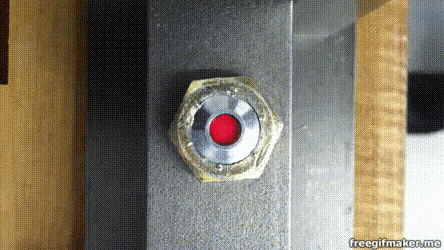
These Bolts Change Color When Tightened Properly
SmartBolts obviate the need for torque wrenches, and make spotting trouble easy
I love torque wrenches, because they let me ensure that dangerous parts like lawnmower blades are properly tightened. But what if you didn't need the torque wrench (which are pretty damned pricey) at all? A company called Stress Indicators Inc. has invented SmartBolts, which feature a red dot in the head when loose. Once the bolt is tightened to the proper torque, it turns black:
 Enter a caption (optional)
Enter a caption (optional)The technology is a boon to maintenance folks, manufacturers and heavy equipment operators, as they can tell, at a glance, whether a bolt is starting to work loose.
"The constant movement of the welding robot was causing the bolts to lose tension," writes an anonymous heavy equipment manufacturer, in a testimonial on the SmartBolts website. "So we decided to retrofit our robots with SmartBolts; now the maintenance technician can look over during welding and visually check that the bolts are secure. This has had a positive impact on improving our overall safety and manufacturing efficiency."
 Enter a caption (optional)
Enter a caption (optional)"We initially had some concern about using these more 'expensive' bolts," writes Yajie Wang, and Advanced Process Engineer at Cooper Standard Automotive, "but after several tests and trials showing their value in added safety, as well as less downtime and visual inspections – it was an easy decision to replace all our mold clamping bolts with SmartBolts. And the appreciation our operators have expressed is priceless!"
As for how it works, the company (unsurprisingly) explains it in broad strokes only:
 "A SmartBolt is a fastener with a built-in visual tension indicator. We call this the Visual Indication System™. As a SmartBolt is tightened, tension forces it to stretch, and our patented Visual Indication System™ correlates fastener tension with color."
"A SmartBolt is a fastener with a built-in visual tension indicator. We call this the Visual Indication System™. As a SmartBolt is tightened, tension forces it to stretch, and our patented Visual Indication System™ correlates fastener tension with color." You can check out pricing here.
-
oFavorite This
-
Q9Comment
K
{Welcome
Create a Core77 Account
Already have an account? Sign In
By creating a Core77 account you confirm that you accept the Terms of Use
K
Reset Password
Please enter your email and we will send an email to reset your password.


Comments
This would be amazing for engine cylinder head bolts.
Except that:
I understand the intent here, but I see several limitations, other than the ones mentioned below. First, the color difference between 50% tight, 75% tight, and 100% tight is barely discernible on the computer screen (see their website), let alone in an industrial setting. If the torque of a bolt is important, a savvy and smart mechanical will double check the bolt torque using a more-reliable torque wrench. Second, dirt and grease are going to get into the indicator port, causing a potentially false reading of black - 100% tight, A-OK, bolt is fine, nothing to see here, move along. Finally, the upper temperature limit of 168F is not that high a temperature for industrial applications. I assume temperatures above this limit will melt the costly plastic indicator in the bolt.
Tension indicatin bolt.
Everone's favorite Uncle BumbleFaak did a basic overview of these last year
Curious as to why they couldn't get them to turn green under correct tension. Does anybody know?
Because its just a red-colored insert that is moving away from the top, falling into shadow, hence "turning black".
It's not exactly falling into shadow. When the bolt is stretched under load the red insert dips into a dark inky dye that hides the indicator rapidly. If it was just shadow then different lighting conditions would totally defeat the indicator while with the dye method it should only marginally affect the result if you were to, say, shine a flashlight right at it.
Jergens has applied this concept for some time to their lift rings.
http://www.jergensinc.com/showcase-lifting-overview